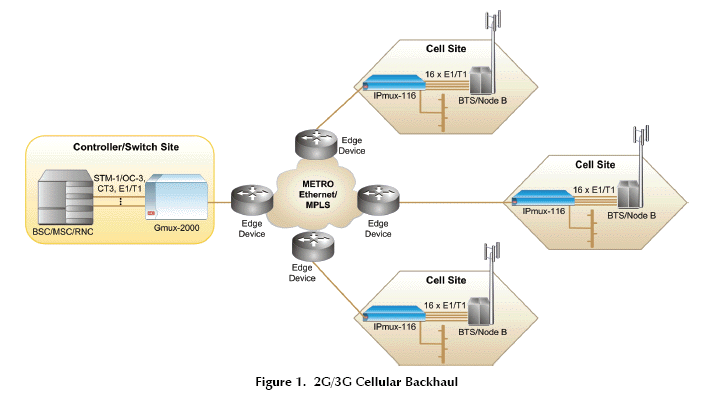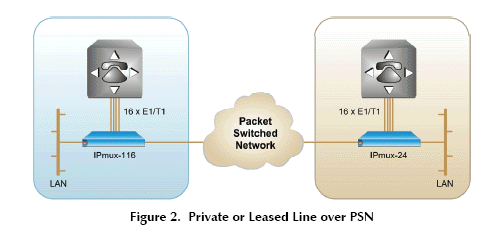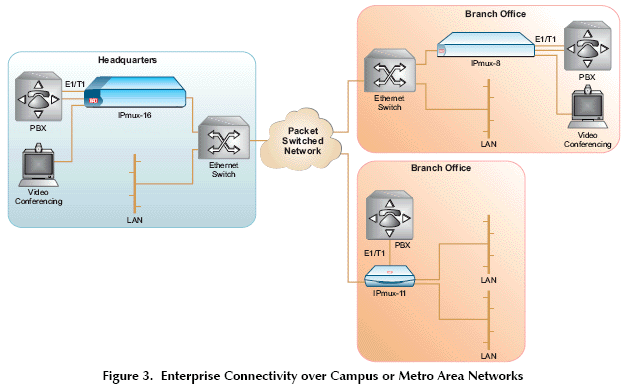




IPmux-116 TDM Pseudowire Gateway
IPmux-116 from RAD provides legacy services over packet networks. The device converts the data stream from its user E1/T1 ports into packets for transmission over the network. The frame format of these packets is IP or MPLS. These packets are transmitted via the IPmux-116 Ethernet network port to the PSN. A remote pseudowire device converts the packets back to the original user traffic format.

IPmux-116 Pseudowire functionality
The ASIC-based architecture provides a robust and high performance pseudowire solution with minimal processing delay.
The IPmux-116 supports various legacy over packet transport types, including TDMoIP, CESoPSN, SAToP, HDLCoPSN.
Proper balance between PSN throughput and delay is achieved via configurable packet size.
A jitter buffer compensates for packet delay variation (jitter) of up to 200 msec in the network.
RAD IPmux-116 Pseudowire QoS/CoS
Ethernet networks – outgoing pseudowire packets are assigned a dedicated VLAN ID according to 802.1Q and marked for priority using 802.1p bits.
IP networks – outgoing pseudowire packets are marked for priority using DSCP, ToS, or Diffserv bits.
MPLS networks – outgoing pseudowire packets are assigned to a specific MPLS tunnel and marked for priority using EXP bits.
IPmux-116 Pseudowire Timing
End-to-end synchronization between circuits is maintained by deploying advanced clock recovery mechanisms.
Clock recovery conforms to G.823 and G.824 traffic interface using G.8261-defined scenarios.
Advanced clock recovery conforms to G.823 synchronization interface using G.8261-defined scenarios and achieves 16 ppb clock accuracy.
The system clock of the IPmux-116 from RAD ensures a single clock source for all TDM links. The system clock uses master and fallback timing sources for clock redundancy. IPmux-116 also provides system clock input and output via an optional external clock port.

IPmux-116 TDM Interface
8 or 16 E1 or T1 ports provide connectivity to any standard E1 or T1 device.
E1 and T1 interfaces support the following:
Integral LTU/CSU for long haul applications
G.703 unframed and G.704 framed modes
CAS and CRC-4 bit generation (E1)
D4/SF and ESF framing (T1)
Robbed bit (T1)
IPmux-116 Ethernet Interface
IPmux-116 provides the following Ethernet ports:
One network port (fiber optic SFP)
One network/user port (fiber optic SFP or built-in 10/100BaseT)
One user port (built-in 10/100BaseT)
The Ethernet ports support autonegotiation, VLAN-tagging/double tagging, filtering and rate limiting.
IPmux-116 Ethernet Capabilities
IPmux-116 features an internal bridge, operating in VLAN-aware and VLAN-unaware modes.
VLAN stacking can be used for traffic separation between different users or services, by defining a service provider VLAN. ID per customer or service. When VLAN stacking is used, a service provider VLAN tag is added to the
user traffic and removed from network traffic. Both service provider VLAN ID and service provider VLAN priority can be defined. The IPmux-116 supports standard IP features, such as ICMP ( ping ), ARP, next hop and default gateway.

IPmux-116 Management
IPmux-116 can be configured and monitored locally via an ASCII terminal, or remotely via Telnet, Web browser or RADview.
Management traffic can run over a dedicated VLAN.
Software download is supported via the local terminal, via XMODEM, or remotely, via TFTP. After downloading a new software version, IPmux-116 automatically saves the previous version in nonvolatile memory for backup purposes. Similarly, copies of the configuration file may be downloaded and uploaded to a remote workstation for backup and restore purposes.
The RADview Service Center and Element Manager packages control and monitor TDM over IP ( TDMoIP ) devices and circuits. The Service Center’s intuitive GUI, “point-and-click” functionality and easy-to-follow wizards increase the efficiency and accuracy of the service provisioning process.
IPmux-116 OAM and Diagnostics
Configuration validation mechanisms ensure proper endto- end pseudowire configuration.
The following RFC-2495 E1/T1 physical layer performance statistics are available: LOS, LOF, LCV, RAI, AIS, FEBE, BES, DM, ES, SES, UAS and LOMF.
IPmux-116 performs an internal built-in test (BIT) after power-up. The results of the test are visible via the local terminal.
LAN and IP layer network condition statistics, such as packet loss and packet delay variation (jitter) are monitored and stored by the device.
Fault isolation, statistics and event logging are available.
Fault propagation initiates service-port alarms, e.g. E1/T1 LOS, to reflect packet network fault conditions. Alarms detected at user ports are propagated to the remote pseudowire device via the packet network.
Diagnostic loopbacks can be activated inband.
Performance monitoring is provided by Ethernet and IP-layer network condition statistics, such as packet sequence errors (loss or misorder) and packet delay variation (jitter), which are monitored and stored by the
RAD IPmux-11.

IPmux-116 TDM Pseudowire Gateway (pdf)